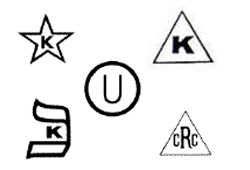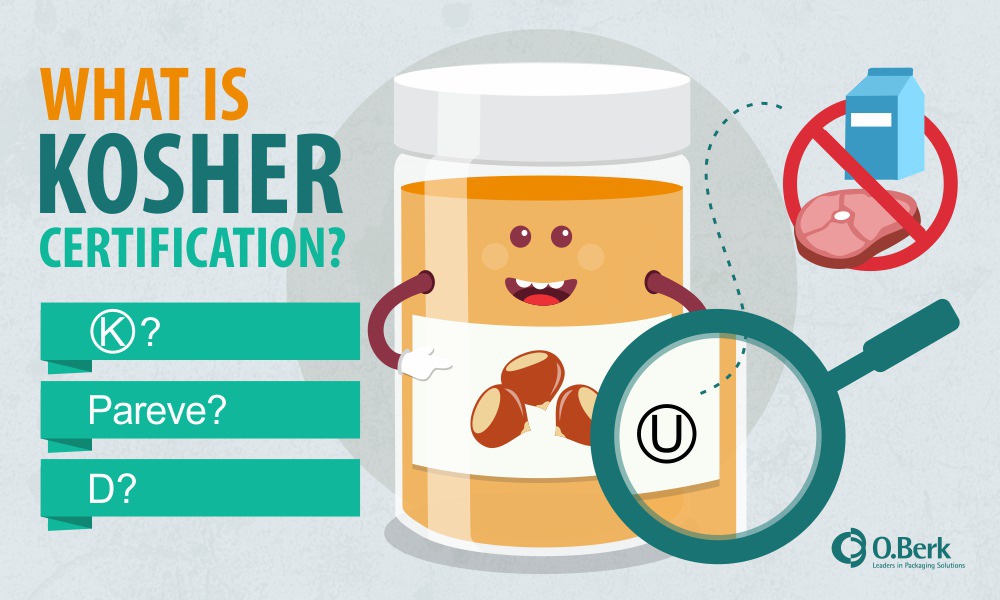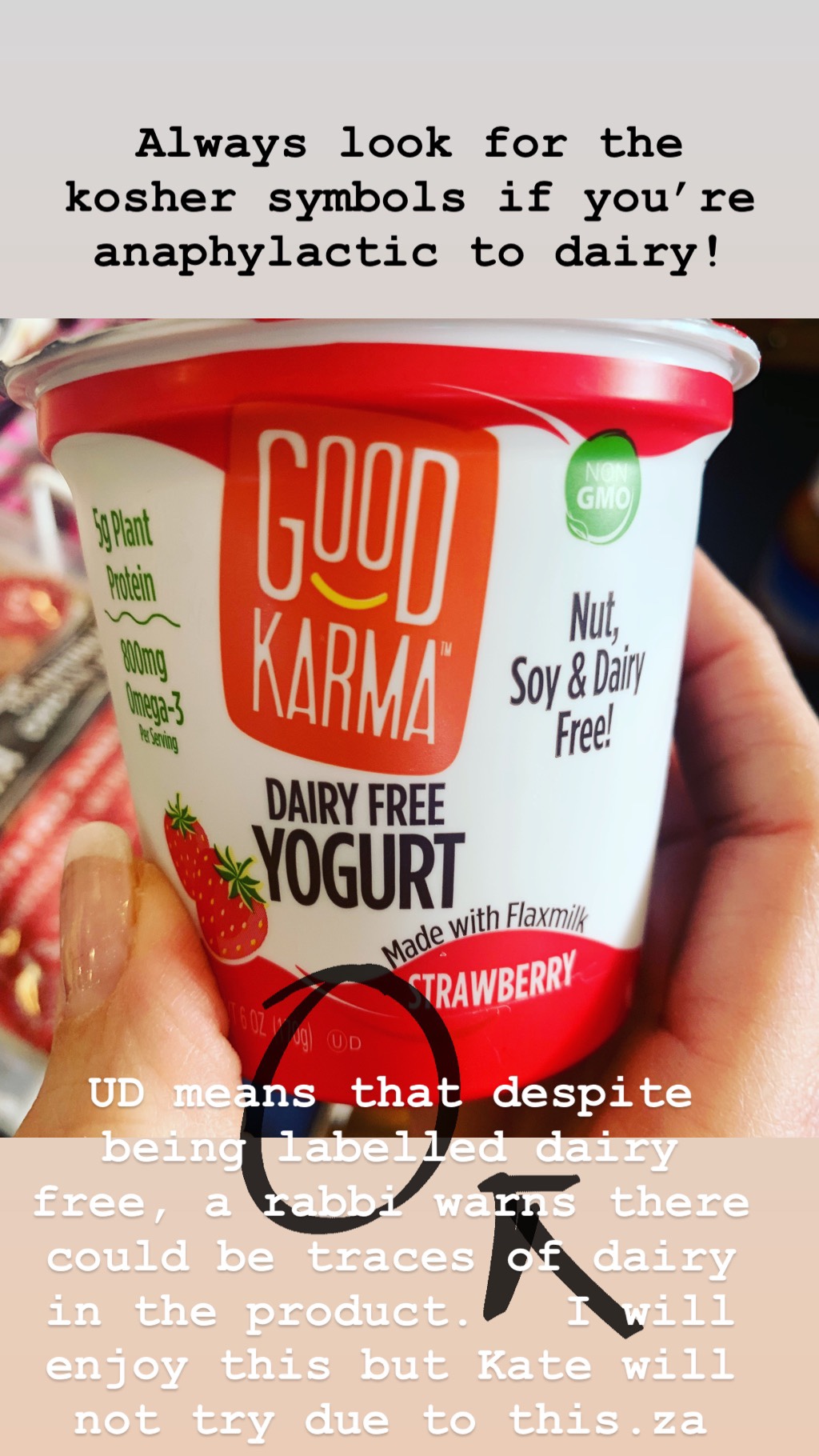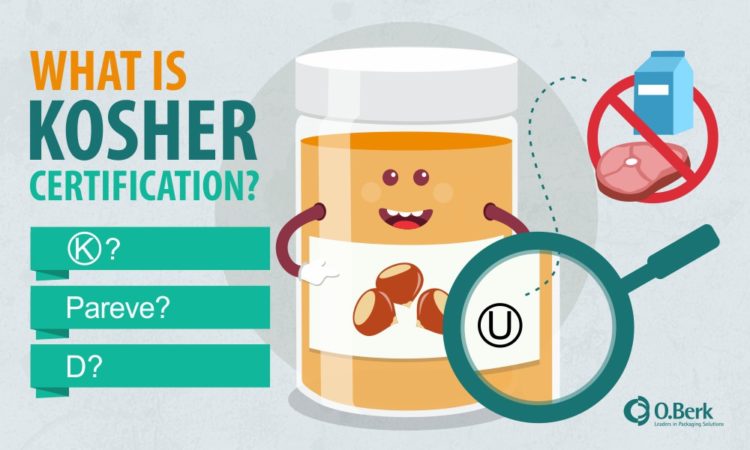Kosher labels have been extremely helpful for us with Kate’s dairy allergy. Learn more about how to understand and use these to cross-reference with ingredient labels and allergy warning statements. It is important to note that these labels are not a substitute for reading the ACTUAL ingredient labels and are not reliable on their own for determining the lack of an allergen in a food item. Be sure to read the entire article below and please don’t hesitate to reach out to me if you have any questions!

Kosher Food: IS IT MEAT, DAIRY OR PAREVE?
Often there are letters or words printed next to the kosher certification symbol on food packages. These are added to inform the consumer of the product’s kosher category. This information can be helpful for people with food allergies as well.
Kosher categories include:
- Meat (Fleishig in Yiddish, Basari in Hebrew),
- Dairy (Milchig in Yiddish, Chalavi in Hebrew) or …
- neither meat or dairy (Pareve in Yiddish, Parve in Hebrew).
Meat:
“Meat”, “M” or “Glatt” printed near the kosher symbol on the food package indicates the product is kosher and contains some meat or meat derivative.
Dairy:
“Dairy” or “D” printed near the kosher symbol on the food package indicates the product is kosher and contains some milk or milk derivative.
Fish:
“F” printed near the kosher symbol on the food package indicates the product is kosher and contains fish ingredients.
Pareve:
“Pareve”, “Parev”, or “Parve” printed near the kosher symbol on the food package indicates the item is neither meat or dairy.

Passover:
“P” printed near the kosher symbol on the food package does not stand for pareve, but instead it means the product is kosher for Passover and all year round.
Furthermore, D-P means dairy and kosher for Passover and all year round. M-P or Glatt-P means meat and kosher for Passover and all year round. F-P means fish and kosher for Passover and all year round.
**Be very careful not to confuse “P” with Pareve…..”P” means that the product is kosher not that it is Pareve.
Kosher certification agencies examine the ingredients used to make the food, supervise the process by which the food is prepared, and periodically inspect the processing facilities to make sure that kosher standards are maintained. Different kosher certifying agencies tend to follow different kosher certification standards, some more strict and others more lenient.
Products that have been certified as kosher are labeled with kosher symbols. The symbols are printed on the food’s package. Kosher symbols are registered trademarks of kosher certification organizations, and cannot be placed on a food label without the organization’s permission.
Kosher symbols not only ensure that the food is kosher, they also identify the kosher certifying organization that issued the certification. More information about each agency, and the kosher standards it maintains, can be found on the agency’s site.
What does this mean for children with Food Allergies?
“Kosher” foods are foods which meet Jewish dietary laws. These dietary laws prohibit the consumption of certain foods, require that foods be processed in certain ways, and, most importantly for the food allergic, prohibit the mixing of dairy products and meat products.
***Although many parents of dairy-allergic children find it convenient to check for the Kosher labeling of a product to see if the product contains dairy ingredients, Kosher labeling is not an accurate way to determine if a product is safe from a food allergy standpoint.
A basic explanation of Kosher labeling from the standpoint of the food allergic is as follows:
- In the Kosher system, foods are classified as being either “dairy,” “meat” or “neutral” (neither dairy nor meat).
- Foods that meet the Kosher dietary laws are labeled with one of the Kosher symbols, including: K, Circle U and Circle K. You can usually find these symbols in small type on the bottom front of the package.
- Kosher foods that contain dairy products usually contain a “D” or the word “Dairy” after the Kosher symbol.
- Kosher foods that are processed on “dairy equipment” (i.e., equipment that is also currently used to process items which contain dairy, or that has been used in the past to process dairy products and has not undergone a ritualized cleaning process since then) may have a “D” or “DE” after the Kosher symbol.
- Kosher foods that are considered neutral (i.e. not “dairy” or “meat”) have the word “Pareve” or “Parve” after the Kosher symbol. Note: under Kosher laws, fish is considered to be “neutral”.
- The letter “P” in Kosher labeling never denotes “Pareve”. “P” designates “Kosher for Passover” (a Jewish holiday which has its own dietary laws).
- Not all foods are Kosher, and therefore not all foods contain a Kosher label.
Some Take Away Points:
- Kosher labeling in general cannot be used as a guide to determining whether a product does or does not contain milk.¹ However, many parents find they can save time in the supermarket by simply assuming that foods marked as “Kosher dairy” are not safe for a dairy-allergic child.
- A dairy-allergic person cannot rely on the Kosher Pareve designation or the lack of a Kosher Dairy designation in determining the safety of a particular food. This is because it is possible for a food to contain a trace level of dairy contamination (something which might be a problem for a dairy-allergic child) and still be considered “dairy-free” from the standpoint of the Jewish dietary laws.
- Kosher labeling does not address cross-contamination issues. Therefore it is possible that traces of allergens may be in Kosher foods, just like any other manufactured foods. As always, be sure to read the ingredient statement on every item purchased and contact the manufacturers to determine its safety just like any other food you would buy.
A note from The Allergy Mom:
As mentioned above, you can not rely solely on kosher labelling when trying to determine if a food is a free from food allergens but it is helpful to use as a cross-reference AFTER reading all other labels on a package. For example, the image below shows a product labelled as Dairy-Free yet upon looking at the kosher symbol and seeing the presence of UD, one can be suspicious that a Rabbi has deemed there is the presence of dairy in the food.

Reference:
Kosher labeling and milk or dairy allergy. Retrieved from http://www.kidswithfoodallergies.org/resourcespre.php?id=100

